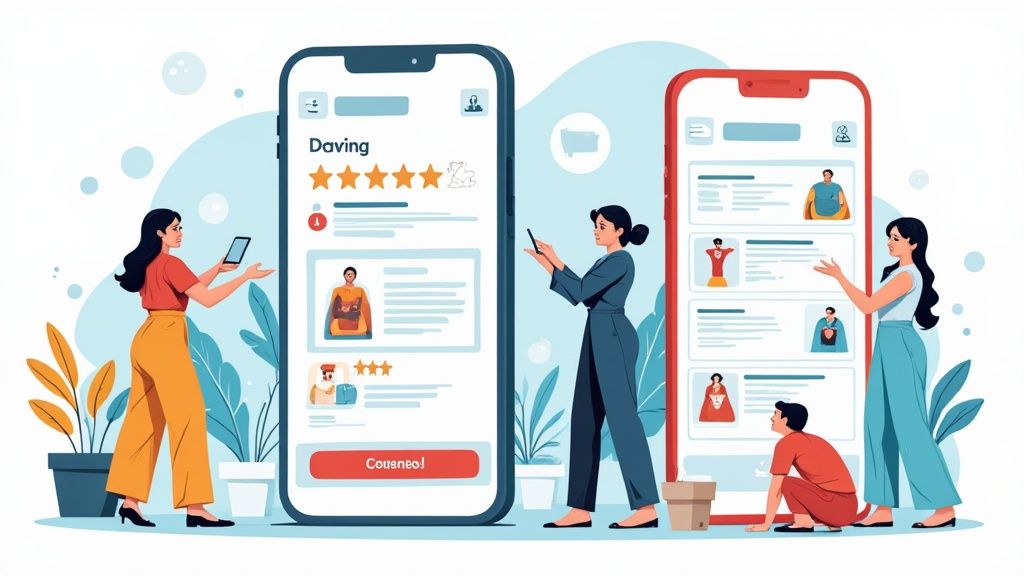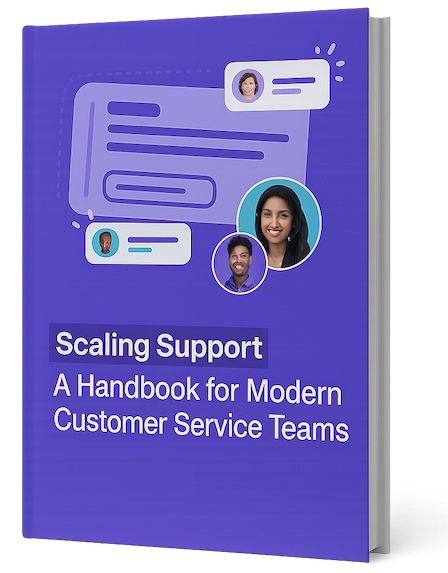Understanding the Strategic Power of Real Time Customer Feedback

Real time customer feedback has become essential for understanding customer needs and experiences. Rather than relying on delayed surveys, businesses can now connect with customers at key moments during their journey. This direct line of communication provides immediate, meaningful insights that help improve products and services.
The Value of Immediacy
Think about describing a meal you had last month versus one you just finished – the recent experience provides much more vivid details. Real time customer feedback works the same way by capturing authentic reactions while customers interact with your business. This leads to more accurate data about how customers really feel. Quick responses to issues also prevent small problems from becoming major frustrations.
Turning Insights Into Action
The speed of real time feedback empowers companies to make rapid improvements. For example, if several customers report a website glitch, the issue can be fixed before affecting more users. This responsive approach shows customers their input matters. Real time feedback significantly improves satisfaction and loyalty since customers know their voice will be heard. Companies like Lowell showcase this by gathering feedback at 14 different touchpoints, enabling staff to address concerns quickly. For more details on implementing real time feedback, check out this guide: 2025 Guide to Collect Real-Time Customer Feedback.
Building a Feedback-Driven Culture
Collecting feedback is just the start – companies need to build feedback into their DNA. This means integrating feedback tools throughout customer interactions, giving teams authority to act on input, and constantly seeking ways to improve. A feedback-driven culture turns customer insights into positive changes that boost satisfaction and retention. When feedback becomes core to operations, businesses can better understand customer needs, spot emerging trends, and create exceptional experiences that keep customers coming back.
Building Powerful Real Time Feedback Channels
Getting meaningful customer feedback requires strategic planning and the right tools. Smart companies go beyond basic surveys to create natural feedback opportunities throughout the customer journey. The key is finding feedback methods that fit seamlessly into how customers already interact with your business.
Selecting the Right Feedback Channels
To build an effective feedback system, you'll want a mix of different options:
- In-App Surveys: Perfect for getting feedback while customers use your product, ensuring responses reflect their actual experience.
- Live Chat: 41% of customers now prefer live chat as their main way to communicate with companies. Live chat helps boost sales and reduce cart abandonment by providing quick answers. Learn more about chat preferences and trends.
- Feedback Widgets: Small, well-placed buttons or forms that let customers share thoughts without disrupting what they're doing.
Understanding When to Ask for Feedback
Timing matters when collecting feedback. Post-purchase surveys work well because customers are naturally engaged after buying something. The goal is making feedback convenient without being pushy, which helps maintain good response rates.
Managing Common Challenges
Setting up feedback channels comes with some hurdles. Here's how to handle them:
- Start Small: Begin with one or two key touchpoints before expanding.
- Train Your Team: Make sure staff know how to professionally handle all types of feedback.
- Keep Improving: Regularly review and update your feedback methods based on what works.
Creating a Complete Feedback System
The end goal is having feedback options that feel natural and helpful rather than forced. When feedback fits smoothly into normal customer interactions, you get better insights while keeping customers happy. This approach helps you gather useful data while showing customers you value their input.
Transforming Data Into Actionable Customer Insights
Raw customer feedback provides valuable data, but to drive real improvements, that data needs to become actionable insights. This means going beyond basic metrics to identify key patterns and trends that can inform strategic decisions.
Using Advanced Analytics
Getting the most out of real-time feedback requires sophisticated analysis methods. Sentiment analysis helps gauge the emotional tone of customer comments, while topic modeling automatically spots common themes in feedback data. For instance, if multiple customers report issues with a specific feature, topic modeling quickly flags this problem area for attention.
Combining Data Sources
Customer feedback becomes much more impactful when analyzed alongside other data points. Merging feedback with purchase history, website analytics, and CRM records creates a complete view of the customer journey. This comprehensive perspective shows how feedback connects to specific interaction points and helps identify which touchpoints drive satisfaction levels up or down. Pairing feedback with operational metrics can also uncover links between customer sentiment and internal processes.
Creating Action Frameworks
To make data-driven decisions consistently, you need clear analytics frameworks defining key metrics, reporting processes, and data access guidelines. Build dashboards that display real-time feedback trends so teams can quickly spot emerging issues. Link platforms like Supportman with team communication tools to enable collaborative responses to feedback. The rise of real-time feedback has enabled companies to instantly connect customer reactions to specific experiences using advanced data tools that map touchpoints to sentiment. This approach works especially well with metrics like Net Promoter Score (NPS), where surveys go out right after customer interactions. Learn more about current feedback trends and metrics here.
Sharing Data Access
While maintaining data quality standards, make sure to give all relevant teams access to feedback insights. Product, marketing, and other groups should be able to access the data they need through dashboards and reports. This creates an organization-wide focus on understanding and acting on the customer experience. With a structured approach to analyzing and sharing data, real-time feedback directly drives business results and higher customer satisfaction.
Creating a Dynamic Response Strategy That Drives Results

Getting customer feedback is just the first step. The real magic happens in how you act on it. A strong response strategy is essential for turning feedback into meaningful improvements and building lasting customer relationships.
Prioritizing and Escalating Feedback
Different feedback needs different levels of attention. Create a clear system to categorize feedback by importance, impact, and frequency. Use tags like "bug report," "feature request," or "general feedback." For urgent issues, set up clear escalation paths to get the right team members involved quickly. Think of it like an emergency room triage – the most critical cases get immediate attention.
Training for Consistent Responses
Building trust requires consistent, high-quality responses. Train your team thoroughly on handling different types of feedback, both positive and negative. Give them clear communication guidelines and resources for common customer issues. Using tools like Supportman with Slack enables quick team discussions and coordinated responses. This helps everyone stay aligned and deliver a unified customer experience.
Maintaining Accountability
Tracking who handles what feedback and measuring response effectiveness is key. Set up systems to monitor which team members are responsible for different feedback items and track their progress. Regular reporting on response times and resolution rates helps identify areas to improve.
Turning Negative Feedback into Opportunities
Negative feedback, while challenging, offers valuable chances to improve and strengthen relationships. When handled well, it can transform an unhappy customer into a loyal advocate. Coach your team to show empathy, apologize sincerely when needed, and actively suggest solutions. Often, simply acknowledging a customer's concerns goes a long way toward rebuilding trust.
Scaling Your Response Capabilities
As you grow, you'll get more customer feedback. Design your response strategy to handle increased volume. Consider automating routine responses, using AI tools to spot trends, and creating self-service resources. By planning ahead, you can maintain excellent service quality even as feedback volume grows. This forward-thinking approach helps you keep delivering great customer service while making the most of feedback insights.
Measuring Impact and Proving ROI

The real value of customer feedback shows up in concrete results. Moving beyond just collecting feedback, companies need to show clear outcomes that matter to decision-makers.
Identifying Key Metrics
Different teams care about different numbers. For executives, real time feedback directly impacts revenue and customer lifetime value. Support teams focus on Customer Satisfaction (CSAT) scores and how quickly issues get fixed. Product teams need to know how customers use features and what needs work based on their direct input.
Calculating ROI
Link feedback to clear outcomes to show its worth. Add up how much you save by fixing problems early through real time feedback versus handling them later. Show how better customer satisfaction leads to keeping customers longer and increasing their value over time. Hard numbers make the business case for investing in feedback systems.
Tracking and Reporting on Feedback Initiatives
Top companies use clear visuals to track key feedback metrics. These charts show trends in how customers feel, response times, and business impacts. Tools like Supportman work with Slack to put feedback data right where teams work. This helps teams spot patterns and work together on responses.
Measuring Customer Satisfaction, Loyalty, and Business Impact
Go deeper than basic metrics. Look at changes in Net Promoter Score (NPS) after adding real time feedback. Watch customer churn rates alongside feedback trends to see the impact on loyalty. Connecting feedback to other business metrics tells a clear story about its value.
Building a Compelling Business Case
Back up requests for more funding with solid data and ROI calculations. Show the potential ahead by highlighting how real time feedback drives new ideas and better operations. For example, showing a 10% boost in customer retention from feedback makes a strong case for growing the program.
Frameworks for Continuous Optimization
Keep testing and improving feedback programs. Regularly check your feedback channels, how you respond, and what you measure. Ask both customers and staff how to make the feedback process better. This ongoing refinement helps your program stay strong and match what the business needs. Regular improvements based on clear results build lasting value.
Building a Future-Ready Feedback Engine

Smart companies know they need effective ways to gather and understand customer feedback. The goal is simple – use tools and methods that help teams capture and analyze customer input faster and better than before. This approach helps companies stay in tune with what customers want.
AI and Machine Learning Make Feedback Smarter
AI and machine learning help support teams work with feedback more intelligently. These tools can process large amounts of customer input and identify key themes automatically. For example, AI groups feedback into categories like "product issues" or "service quality," so teams know where to focus. Machine learning also helps predict customer needs based on past feedback patterns.
Using Data to Anticipate Customer Needs
Smart data analysis takes feedback to the next level. By connecting feedback with other customer information, companies can spot needs early and personalize their approach. This means offering help before customers have to ask. Think of a customer mentioning a small issue through a feedback form – data analysis can flag if similar cases turned into bigger problems before, letting teams step in proactively.
Growing Your Feedback System
As companies expand, they need feedback systems that can keep up. This means having solid platforms that work well even with more data and users. Tools like Supportman connect smoothly with platforms like Slack, helping teams handle customer feedback efficiently. Good integration means feedback reaches the right people quickly.
Getting Started: Key Steps
Making changes to feedback systems takes work, but you can break it down into clear steps:
- Start Small: Pick one or two key customer touchpoints. Add feedback tools there and learn from the results.
- Connect Your Tools: Choose feedback systems that work well with your current software.
- Help Your Team Learn: Make sure everyone knows how to use the new tools and respond to feedback.
- Keep Improving: Watch how your feedback process works and make it better based on what you learn.
A strong feedback system needs regular updates and smart use of new tools. Using AI, machine learning, and smart data analysis helps you understand customers better and deliver great experiences. This focused approach helps your business stay strong as markets change.
Want to improve how you handle customer feedback? Try Supportman free and see how easy it is to collect feedback through Slack.


